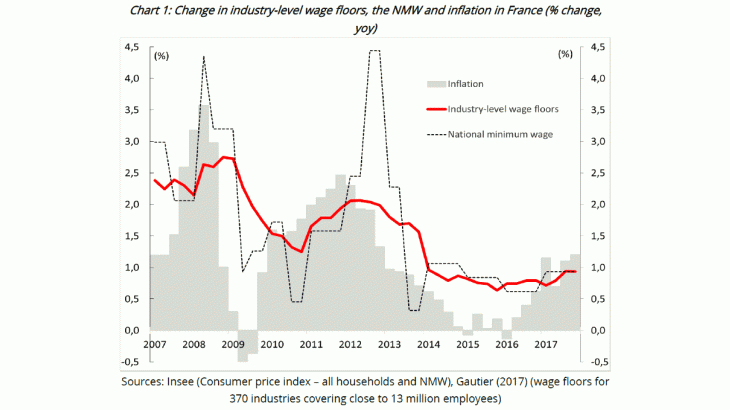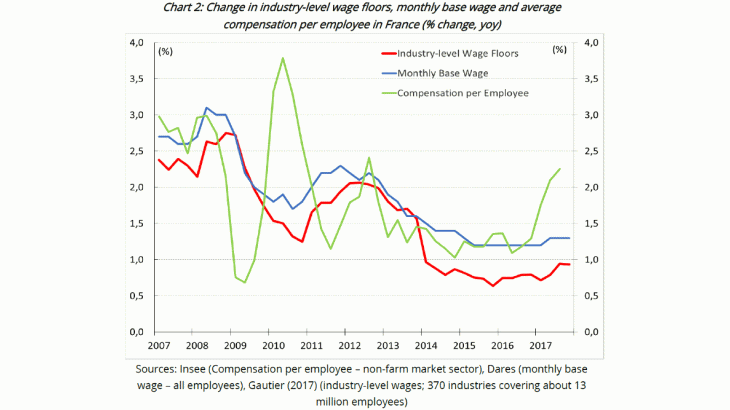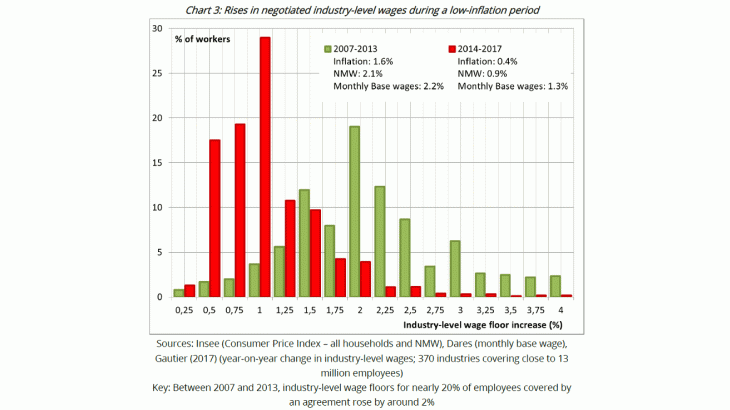Post n°49. Since 2008, growth in nominal industry-level wage floors in France has slowed progressively. In a near-zero inflation environment, wage floors have risen by less than 1% per year since 2014. Increases in negotiated wages are largely determined by past inflation and by changes in the national minimum wage (NMW). As a result, the upturn in inflation observed in 2017 could lead to slightly stronger growth in nominal negotiated wages in 2018.

In spite of the economic recovery, inflation in the euro area is still weak. In France, after remaining stuck below 0.5% between 2014 and 2016, inflation began to recover again in 2017, rising to an annual rate of 1.4% in January 2018. For monetary policy, wage growth is a key variable for appreciating progress towards a sustained adjustment in the path of inflation: “Wage growth […] is the lynchpin of a self-sustained increase in inflation,” (statement by Mario Draghi following the Governing Council meeting of March 2017). In France, as in many other euro area countries, wages are largely set through institutional bargaining mechanisms. However, since 2014, nominal wages have risen at a relatively slow pace (Chart 1). Will the economic recovery and the upturn in inflation observed in 2017 lead to an acceleration in negotiated wages in 2018?
Growth in negotiated wages has slowed against a backdrop of very low inflation
In France, wages are set at three levels (Gautier 2017). At the national level, the national minimum wage (NMW) sets the minimum hourly rate for all employees. It is revised each year in January according to a legal rule that takes into account past inflation and changes in the purchasing power of the blue-collar base wage. This wage increase affects one in ten employees. At the sectoral level, unions and employer associations agree on wage floors for a set of jobs that are representative of their particular industry. These wage floors are renegotiated annually, usually at the start of the year, and apply to some three-quarters of private sector employees. Lastly, at individual firm-level, employers and employees can sign their own collective wage agreements. This form of agreement applies to some 15% of workers, mainly in large firms.

The monthly base wage and industry-level negotiated wages follow similar trajectories (Chart 2). However, the base wage generally rises at a higher rate than industry wage floors as it includes pay rises negotiated within individual firms or by individual employees, on top of any adjustments to the floor. The monthly base wage accounts for 80% of total employee compensation. During an economic recovery, growth in total compensation can also be boosted by the variable components of an individual’s pay, such as overtime and bonuses. Thus, at the end of 2017, average compensation per employee, which includes overtime and bonuses, rose at a higher rate than the monthly base wage or than negotiated wages (Chart 2). Moreover, growth in negotiated wages and in the monthly base wage is measured assuming no change in the workforce composition, whereas average compensation per employee takes into account changes in the workforce composition (in terms of skills and part-time work).
Since 2008-09, growth in nominal negotiated wages has gradually slowed in line with the declines in inflation and in productivity gains. From 2007 to 2009, industry-level wage floors rose at an annual rate of over 2%, despite the 2008 crisis and the falls in labour productivity. However, from 2010 to 2013, this rate slowed to 1.5% per year and, more recently, from 2014 to 2017, it has remained below 1%. Among the main euro area economies, Italy has seen comparable growth to France in negotiated wages: between 2014 and 2017 they rose by 0.9% per year in nominal terms, compared with around 2% growth for the period 2007-13. In contrast, in Germany, where the unemployment rate was under 4% of the working population in 2017, growth in nominal negotiated wages has remained robust, averaging around 2.5% per year from 2014 to 2017.
Growth in negotiated wages depends on past inflation and changes in the minimum wage
The slower growth in negotiated wages observed since 2014 can be explained by less regular wage agreements, but also by a reduction in the size of the bargained adjustments (Chart 3). The near-zero inflation period has been characterised by wage-floor rises of 1% or less, whereas prior to 2014 the increases were clustered around the 2% level. That said, in real terms, average growth in negotiated wages has remained positive and has even accelerated a little since 2014 (0.4% growth prior to 2014 and 0.6% growth after 2014).
Rises in industry-level wage floors are mostly driven by two factors: inflation and changes in the NMW (Fougère et al. 2016). The reference used for wage bargaining in a given year is the inflation level observed in the previous year. Thus, a pick-up in inflation will not translate immediately into an increase in negotiated pay. The NMW, which is indexed to past inflation, is also used as a reference for wage bargaining. As a result industry-level wages are even more closely correlated with past levels of inflation. Although negotiated wages are highly dependent on past inflation, they are less sensitive to changes in business conditions or unemployment.

2018: towards slightly stronger growth in negotiated wages?
Inflation as measured by the consumer price index has started to rise again, owing to the sharp fluctuations in energy prices, and in 2017 reached an annual average of 1%, up from 0.6% in 2016. This contributed to a slightly larger 1.2% rise in the NMW at 1 January 2018, compared with increases of 0.9% and 0.6% in 2017 and 2016 respectively. In 2018, it is possible therefore that we could see higher growth in wages. Industry-level wage bargaining is seasonal, and the vast majority of industries sign agreements in the first quarter of the year. Consequently, the pay rises agreed at the start of the year are a leading indicator of how wages will progress over the rest of the year.
The first wage negotiations for 2018 indicate that the gradual pick-up in industry-level wages is continuing (Chart 4). In those industries that have already signed an agreement for 2018, the average rise has been 1.2% compared with 1% in 2017 and less than 1% in 2016. That said, even though growth in negotiated wages is accelerating, it is still below the pace seen in 2007-13 as inflation remains at a lower level.

A few examples of industries with more than 100,000 employees that have signed an agreement for 2018
In the services sector, the industry-level agreement for “automobile services” contains an average pay rise of 1.3% for 2018 (compared with rises of 1% in 2017 and 0.8% in 2016). In “cleaning activities”, the agreement includes a 1% rise in wage floors for 2018 (compared with increases of 0.7% in 2017 and 0.8% in 2016). In manufacturing, wage agreements in the metallurgy, plastics and pharmaceuticals industries provide for an average pay rise of 1.2% in 2018 (compared with 0.8%, 1% and 0.8% respectively in 2017).
Updated on 10 April 2024